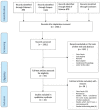Liquid biopsy in the assessment of microRNAs in oral squamous cell carcinoma: A systematic review
- PMID: 36320672
- PMCID: PMC9617270
- DOI: 10.4317/jced.59736
Liquid biopsy in the assessment of microRNAs in oral squamous cell carcinoma: A systematic review
Abstract
Background: The identification of non-invasive biomarkers from biological fluids collected by liquid biopsy provides new horizons for individualized therapeutic strategies and improves clinical decision-making in OSCC patients. Circulating microRNAs have emerged as biomarkers that may reflect not only the existence of cancer, but also the dynamic, malignant potential, and drug resistance of tumors. The aim of the systematic review is to evaluate and summarize the results of the published studies regarding the use of microRNAs as biomarkers for OSCC.
Material and methods: A literature search was conducted on PubMed, Scopus, Web of Science, and Cochrane databases till November 2020. A total of 34 studies met the inclusion criteria and were therefore subjected to quality assessment. Each study was subjected to data extraction including; patient characteristics, type of fluid sample (whole blood, plasma, serum, or saliva), molecular analysis method, specific dysregulated microRNA, and microRNA expression pattern.
Results: The analysis showed that 57 microRNAs of liquid biopsy samples of four different fluids (whole blood, serum, plasma, and saliva) were analyzed. The prognostic and therapeutic significance of these microRNAs were suggested by several studies; where 41 microRNAs were upregulated while 16 were downregulated.
Conclusions: Scientific evidence supports the interest in the use of microRNAs in the diagnosis and prognosis in OSCC patients; however, further studies in a larger cohort of patients are mandatory to introduce liquid biopsy in the routine clinical practice for the OSCC management. Key words:Biomarkers, liquid biopsy, microRNA, oral squamous cell carcinoma, systematic review.
Copyright: © 2022 Medicina Oral S.L.
Conflict of interest statement
Conflicts of interest All the authors have no conflict of interest.
Figures
Similar articles
-
Expression Analysis of Circulating microRNAs in Saliva and Plasma for the Identification of Clinically Relevant Biomarkers for Oral Squamous Cell Carcinoma and Oral Potentially Malignant Disorders.Cancers (Basel). 2024 Aug 28;16(17):2990. doi: 10.3390/cancers16172990. Cancers (Basel). 2024. PMID: 39272848 Free PMC article.
-
miRNAs in liquid biopsy for oral squamous cell carcinoma diagnosis: Systematic review and meta-analysis.Oral Oncol. 2019 Dec;99:104465. doi: 10.1016/j.oraloncology.2019.104465. Epub 2019 Nov 20. Oral Oncol. 2019. PMID: 31756680
-
Salivary Biomarkers for Oral Squamous Cell Carcinoma Diagnosis and Follow-Up: Current Status and Perspectives.Front Physiol. 2019 Dec 10;10:1476. doi: 10.3389/fphys.2019.01476. eCollection 2019. Front Physiol. 2019. PMID: 31920689 Free PMC article. Review.
-
Predictive Prognostic Value of Tissue-Based MicroRNA Expression in Oral Squamous Cell Carcinoma: A Systematic Review and Meta-analysis.J Dent Res. 2018 Jul;97(7):759-766. doi: 10.1177/0022034518762090. Epub 2018 Mar 13. J Dent Res. 2018. PMID: 29533734
-
Diagnostic Value of CircRNAs as Potential Biomarkers in Oral Squamous Cell Carcinoma: a Meta-Analysis.Front Oncol. 2021 Jul 8;11:693284. doi: 10.3389/fonc.2021.693284. eCollection 2021. Front Oncol. 2021. PMID: 34307158 Free PMC article.
Cited by
-
Identification of Stage-Specific microRNAs that Govern the Early Stages of Sequential Oral Oncogenesis by Strategically Bridging Human Genetics with Epigenetics and Utilizing an Animal Model.Int J Mol Sci. 2024 Jul 12;25(14):7642. doi: 10.3390/ijms25147642. Int J Mol Sci. 2024. PMID: 39062890 Free PMC article.
-
Role of transcriptomics in the study of oral cancer.Front Oral Health. 2025 Jul 28;6:1524364. doi: 10.3389/froh.2025.1524364. eCollection 2025. Front Oral Health. 2025. PMID: 40791779 Free PMC article. Review.
-
Expression Analysis of Circulating microRNAs in Saliva and Plasma for the Identification of Clinically Relevant Biomarkers for Oral Squamous Cell Carcinoma and Oral Potentially Malignant Disorders.Cancers (Basel). 2024 Aug 28;16(17):2990. doi: 10.3390/cancers16172990. Cancers (Basel). 2024. PMID: 39272848 Free PMC article.
-
Downstream Target Analysis for miR-365 among Oral Squamous Cell Carcinomas Reveals Differential Associations with Chemoresistance.Life (Basel). 2024 Jun 10;14(6):741. doi: 10.3390/life14060741. Life (Basel). 2024. PMID: 38929724 Free PMC article.
-
A new perspective on diagnostic strategies concerning the potential of saliva-based miRNA signatures in oral cancer.Diagn Pathol. 2024 Nov 16;19(1):147. doi: 10.1186/s13000-024-01575-1. Diagn Pathol. 2024. PMID: 39548527 Free PMC article. Review.
References
-
- Ferlay J, Soerjomataram II, Dikshit R, Eser S, Mathers C, Rebelo M. Cancer incidence and mortality worldwide: Sources, methods and major patterns in GLOBOCAN 2012. Int J Cancer. 2015;136:E359–E386. - PubMed
-
- Arantes LMRB, De Carvalho AC, Melendez ME, Carvalho AL. Serum, plasma and saliva biomarkers for head and neck cancer. Expert Rev. Mol. Diagn. 2018;18:85–112. - PubMed
Publication types
LinkOut - more resources
Full Text Sources
Miscellaneous


